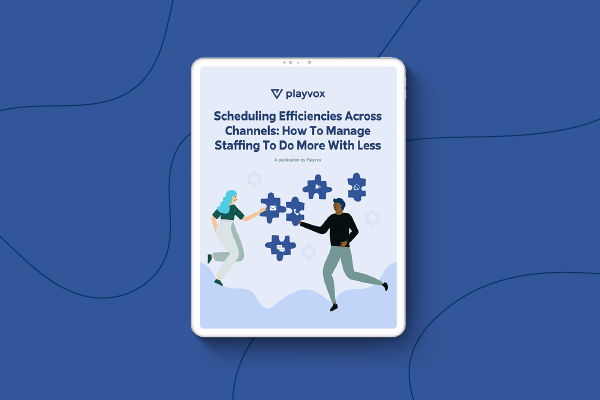WFM Scheduling

Book a personalized demo with a Playvox expert
What is WFM Scheduling?
WFM Scheduling is a workforce management process to determine how many people you need scheduled for a specific type of work at various times throughout the day. In contact centers, it’s not as simple as I have 30 people and I need to cover these hours.
Each agent is trained on specific types of interactions, which translates to the agent’s skills. When the contact center has multiple channels — and at this point nearly every business has a minimum of two channels of communication — priority also has to be made between which channel should be routed to the agent with the right skills first.
And if that’s not complicated enough you also need to take into account historical volume trends over time which tell you at which times of the day and days of the week you need more, or less, people to cover the appropriate shifts on the various channels. Let’s not forget about agent availability. A WFM scheduling process needs to account for agents availability over time so that you do not diminish agent satisfaction and lose staff.

Why is WFM Scheduling So Important?
Without the proper staff scheduled, the business will suffer in one of two ways. They will be understaffed which will create bad experiences for customers, and result in churn. It will also result in excessive overtime costs because they will need staff to stay and work extra to make up for the bad scheduling. Or the business will be overstaffed, which will result in again excessive costs to have staff in place when they are not needed and not busy.
Getting scheduling right as a part of your workforce management efforts is critical to manage operational costs, and create strong customer experiences. Customer retention is critical, and scheduling the appropriate staff on the preferred channels for customers will help drive loyalty.
How to Do Scheduling in WFM
To accurately schedule staff based on skills and priorities across all of the different channels within a business, is not an easy task. First it’s critical to understand historical volumes by channel, and how many interactions per hour, per channel are typically handled by a person. This may include understanding concurrent volume and first agent handle time depending on the types of channels you have in your business.
Next you need to understand the skills of your agents, and which channels they are trained to support. This will help you understand the available staff you have by channel so you can begin to populate a schedule based on the volume of work.
And finally you need to account for priority within your channels. If you have blended agents working on simultaneous channels, it’s important that the system knows which channel takes priority and can route interactions appropriately.
As you can imagine this becomes increasingly hard to do manually, let alone manage in real-time as volume and priorities change. Having a strong solution in place that will help manage all of these intricate details for you, and automatically schedule the optimal staff based on historical trends and your staff will make life a lot easier.
What are the Benefits of Using a WFM Solution for Scheduling?
There are some clear benefits of using a WFM solution to manage your scheduling. We can start with the obvious one of automation. A WFM solution will account for agent skills, priorities across channels, agent availability, and historical trends in volume and identify the most optimal shift for your business. This is a huge time saver and efficiency booster. A WFM solution will also easily help you identify which channels that customers are demanding to communicate on. This also allows you to plan better for future staffing needs and also make intraday changes as volumes change. Without a WFM solution, making those real-time adjustments to staff becomes impossible. This also gives you visibility if you need additional agents or need to offer overtime to account for real-time business changes. Without a solution you could not make these on-demand changes, which will lead to bad experiences for your customers. And finally, without a WFM scheduling solution planning for the future is near impossible. A solution will have access to all of your historical trends, but it also captures important pieces of data like agent skills, agent availability, scheduled leave requests, and even scheduled training. Long-term planning is an effortless part of your work when you have a solution that will automate a lot of the thinking for you.





